Summary
In the bustling world of business, the term "startup" has become something of a buzzword, conjuring images of young tech geniuses crafting the next groundbreaking app in a garage or a small team disrupting an entire industry with an innovative idea. At its core, a startup is a company in its initial stages of operations, built to solve a particular problem or address a specific need in the market. Unlike traditional businesses, startups often aim to grow aggressively over a short period, driven by innovation and a scalable business model.
But not all startups are the same. They differ in terms of their industry focus, business model, type of innovation, funding stage, which is where knowing the differences between venture capitalists and angel investors comes into play, and scalability. Understanding these classifications is essential not just for entrepreneurs but also for investors, potential employees, and anyone interested in the ecosystem. These categories offer clarity, helping to set expectations, determine strategy, and predict challenges.
In this article, we'll delve into these classifications, shedding light on the diverse landscape of startups and highlighting the unique characteristics of each type. Whether you're an aspiring entrepreneur, an investor looking for the next big thing, or simply a curious reader, this guide aims to provide a comprehensive overview of the dynamic world of startups.
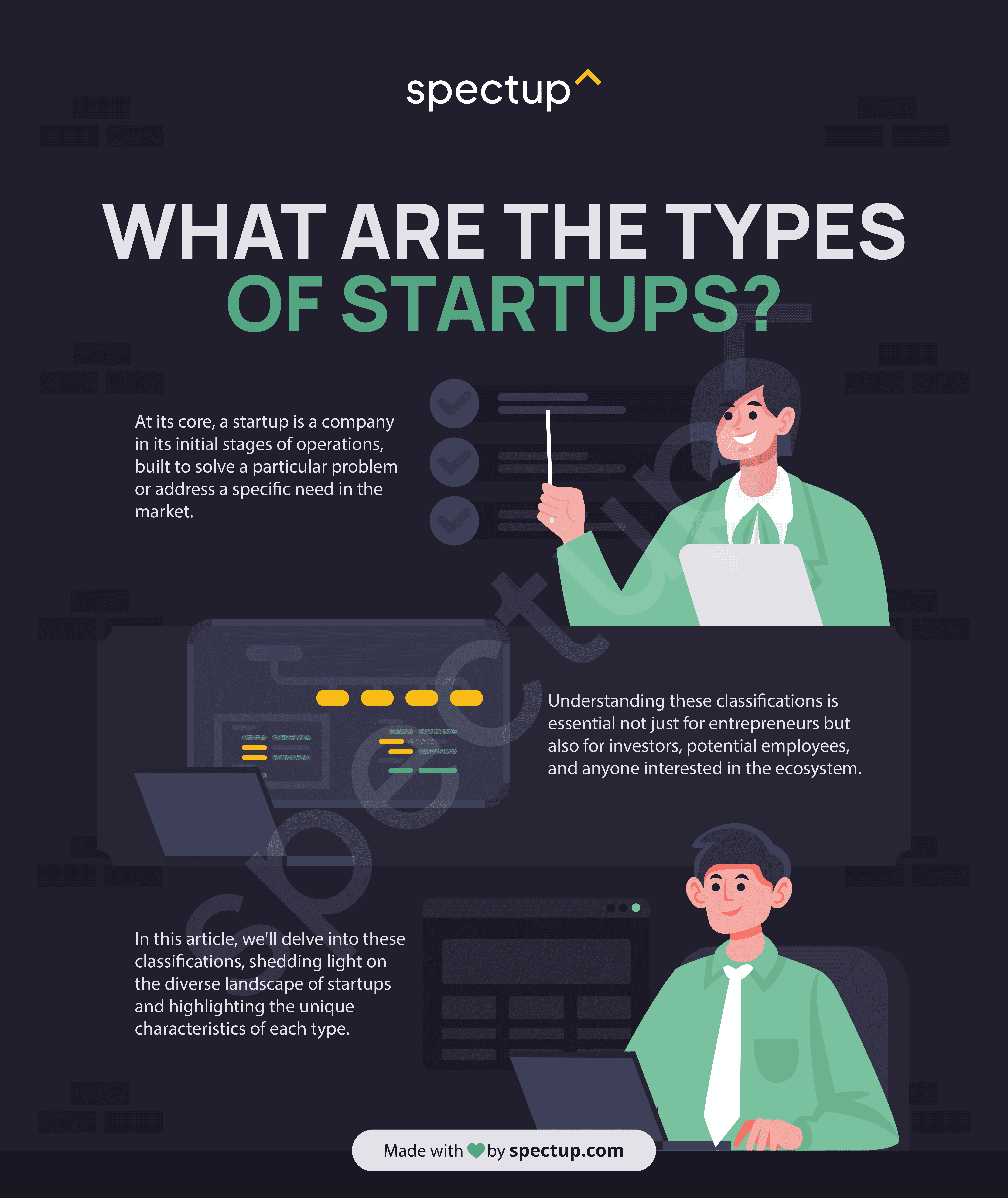
Classification Based on Industry
Startups have flourished in virtually every sector imaginable. While the term 'startup' might instantly evoke images of Silicon Valley and tech innovations, the startup ethos of identifying problems and crafting novel solutions is universal. Below, we explore various industries where startups have made significant inroads:
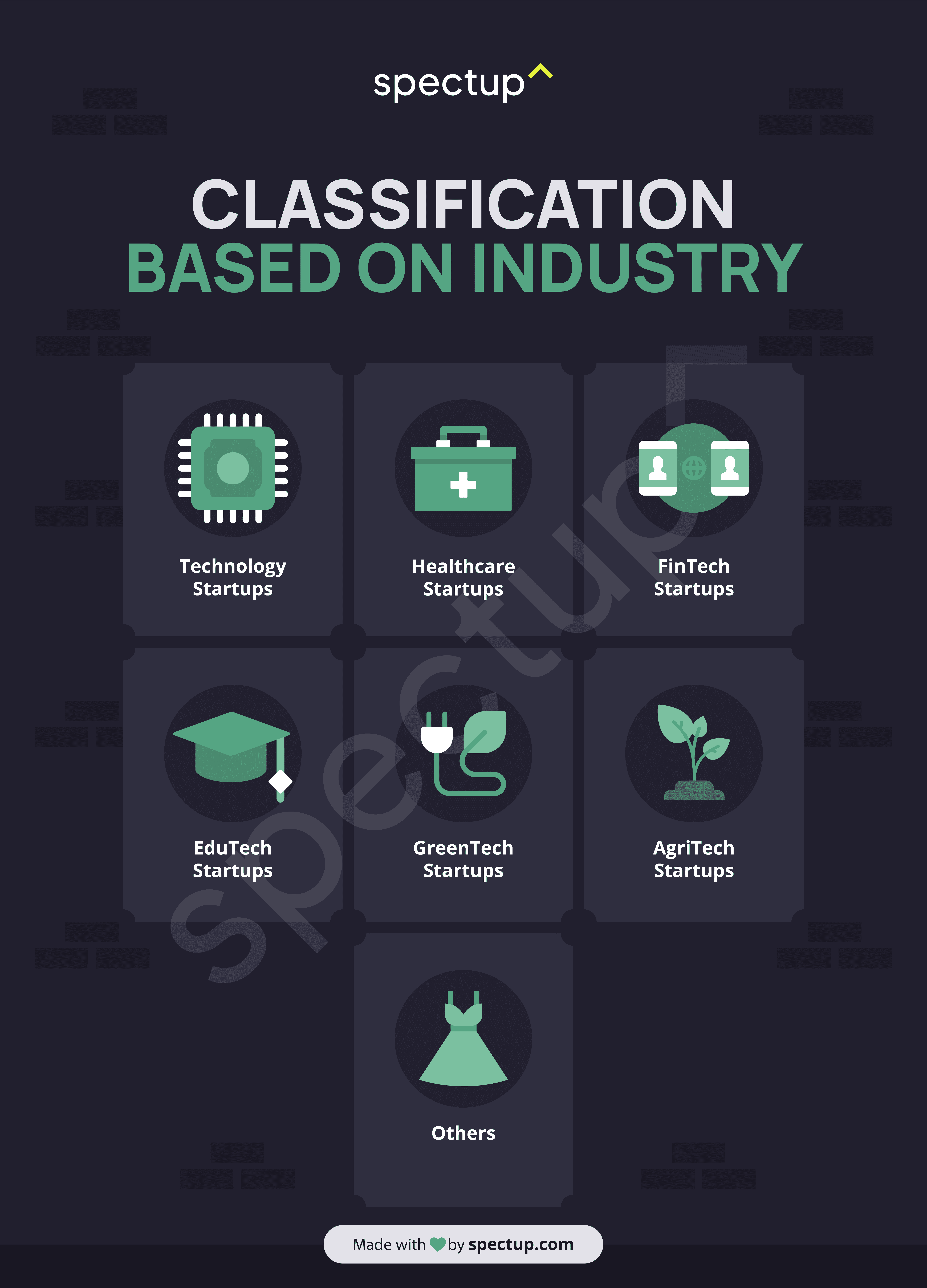
Technology Startups
These are perhaps the most recognized. They encompass a vast array of innovations in software development, artificial intelligence, hardware solutions, and more. Prominent examples include companies like Facebook in its early days, or more recent unicorns like Slack and Zoom.
Healthcare Startups
The world of medicine and healthcare is no stranger to innovation. Startups in this category often focus on biotechnology, medical devices, telehealth platforms, and novel health services. Firms such as Moderna and Teladoc have made significant strides in transforming healthcare through technology.
FinTech Startups
The financial sector, with its traditional institutions and practices, has witnessed a wave of disruption from startups. Innovations here range from digital wallets and peer-to-peer lending platforms to robo-advisors and blockchain-based solutions. Companies like Square, Robinhood, and Ripple exemplify this category.
EduTech Startups
With the evolving demands of the global education landscape, startups have risen to provide technological solutions to enhance learning. This category includes platforms for online courses, learning management systems, and AI-driven educational tools. Coursera and Duolingo stand as notable mentions in this space.
GreenTech Startups
In response to global environmental challenges, GreenTech (or CleanTech) startups focus on creating sustainable solutions. This category includes innovations in renewable energy, waste management, water purification, and more. Tesla, with its electric vehicles and energy solutions, has been a trailblazer in this arena.
AgriTech Startups
Agriculture, one of the oldest industries, is not exempt from the startup revolution. AgriTech startups are harnessing technology to boost crop yields, manage farms efficiently, and reduce environmental impact. Companies like Indigo Agriculture and AeroFarms offer insights into this category's potential.
Others
Beyond these categories, the startup landscape is vast. We have PropTech transforming real estate, FashionTech startups revolutionizing the world of fashion with sustainable and tech-driven solutions, FoodTech startups reimagining food production and delivery, and so much more.
In essence, the industry-based classification emphasizes the versatility and reach of the startup mindset. Whether it's revolutionizing century-old sectors or creating entirely new markets, startups continue to redefine the boundaries of business and innovation.
Classification Based on Business Model
The way a startup plans to make money and engage with its customers is crucial to its operational strategy and long-term viability. This is encapsulated in its business model. Understanding a startup's business model provides insights into its target audience, growth strategies, revenue streams, and value proposition. Let’s delve into the primary business models adopted by startups:
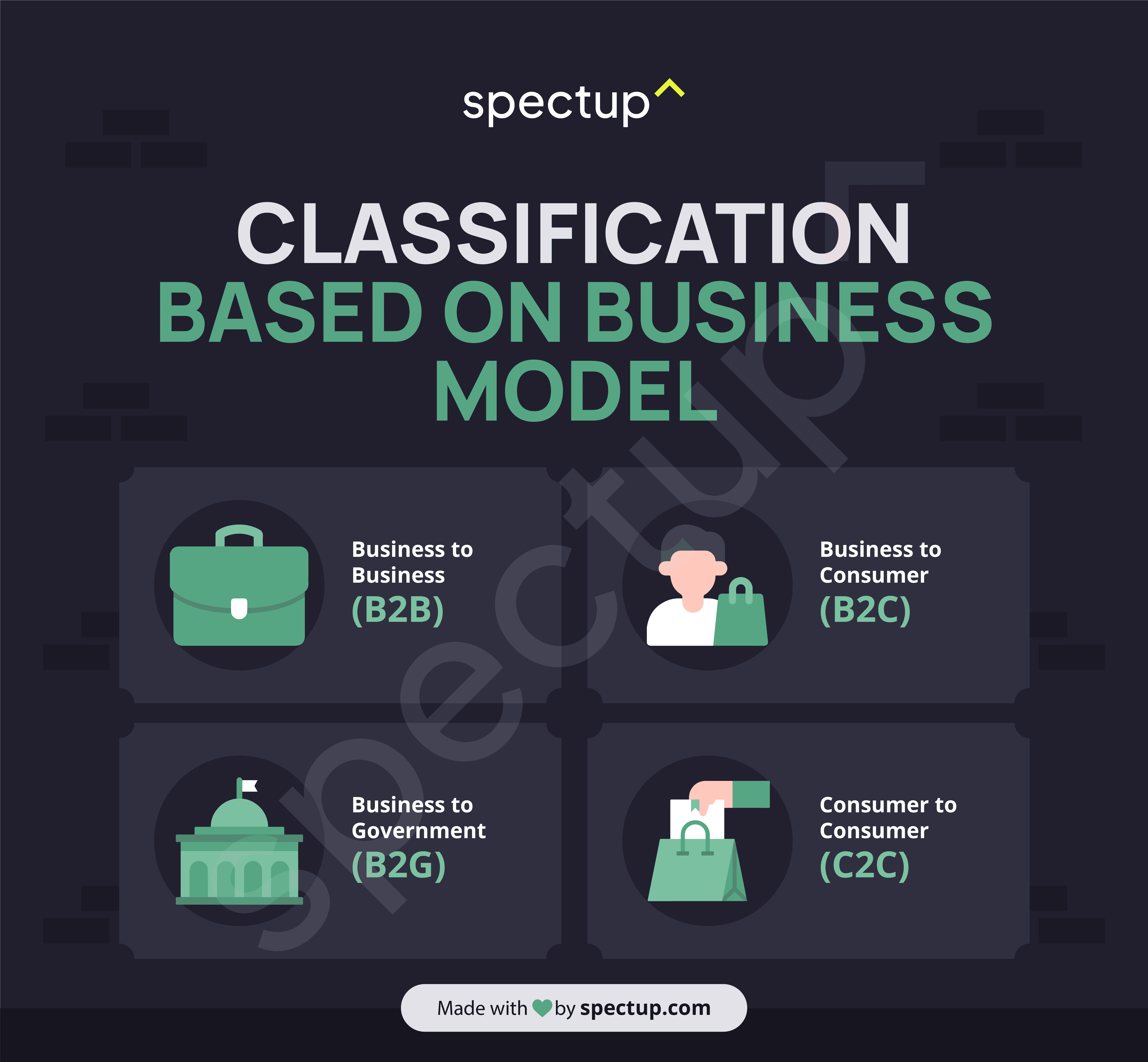
B2B (Business-to-Business)
These startups cater to other businesses, offering products or services that help them operate more efficiently or effectively. This model often requires building strong, long-term relationships with business clients. Examples include software solutions like Salesforce, which provides customer relationship management tools for other businesses, or Dropbox Business, which offers cloud storage solutions tailored for companies.
B2C (Business-to-Consumer)
B2C startups target end consumers directly. Their success often hinges on widespread brand recognition and a large user base. Examples abound, from e-commerce platforms like Amazon to ride-sharing apps like Uber. The focus here is on reaching and satisfying individual consumers.
B2G (Business-to-Government)
A niche yet significant model, B2G startups provide solutions tailored for government agencies and public institutions. This can range from infrastructure projects to software for public record management. Navigating bureaucratic processes and adhering to stringent regulations are common challenges here. Companies like Palantir Technologies, which offers data analytics solutions for government applications, exemplify this category.
C2C (Consumer-to-Consumer)
C2C platforms facilitate transactions between consumers, allowing them to buy and sell goods or services among themselves. Startups in this space often act as intermediaries, ensuring trust, security, and convenience. eBay, a marketplace for consumers to sell items to each other, and Airbnb, which lets homeowners rent out their spaces to travelers, are renowned examples of this model.
In summation, the chosen business model often defines a startup's approach to market penetration, customer relations, and revenue generation. As the startup ecosystem continues to evolve, we see hybrids and variations of these models emerging, underlining the fluid and innovative nature of the startup world.
Classification Based on Innovation Type
Innovation is the lifeblood of startups. However, not all innovations serve the same purpose or achieve the same impact. Distinguishing between types of innovations can provide deeper insights into a startup's objectives, its approach to market dynamics, and its potential to shape or disrupt an industry. Here are the primary classifications based on the type of innovation:
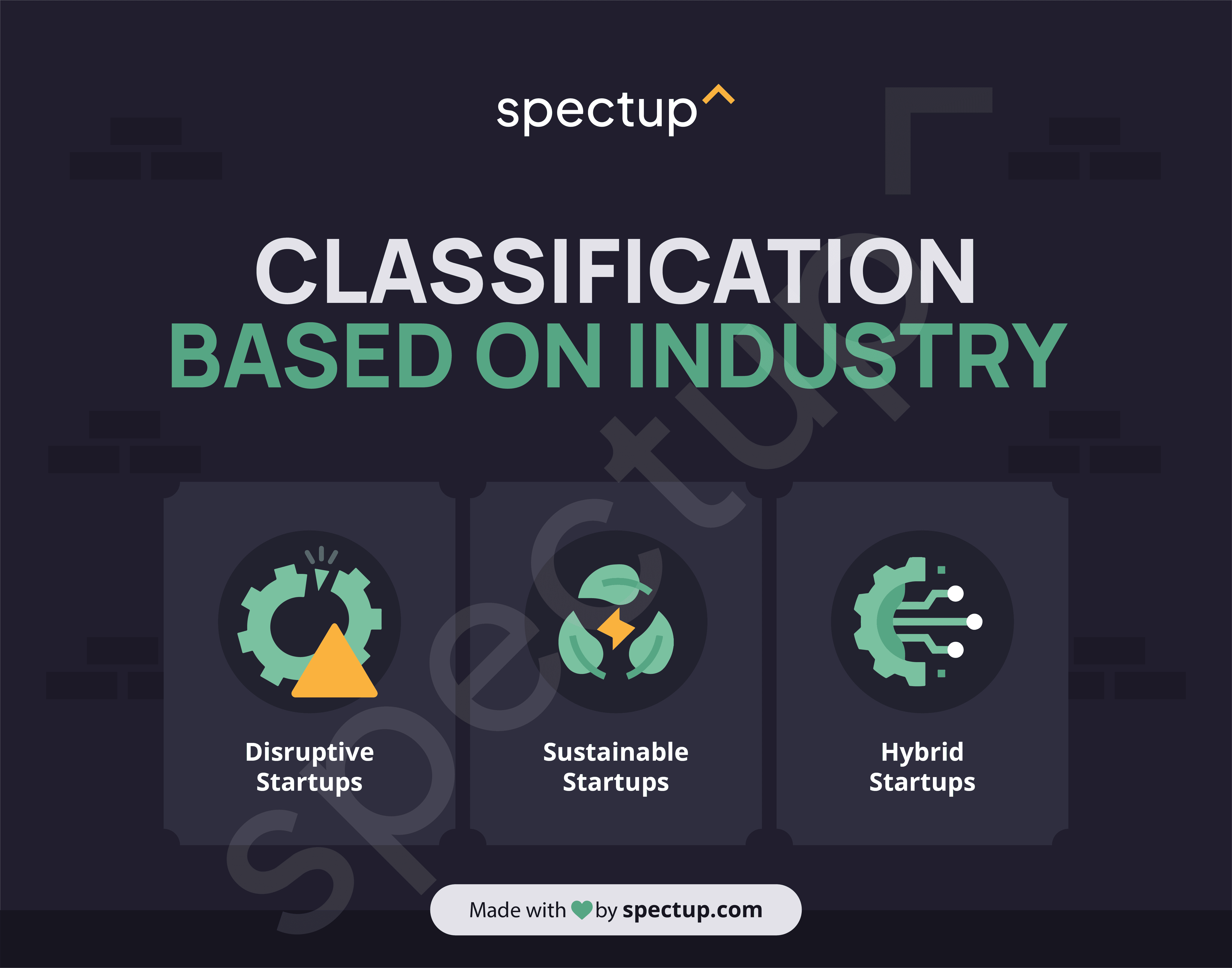
Disruptive Startups
These startups aim to revolutionize an industry by introducing innovations that challenge, and sometimes replace, the status quo. Disruptive startups often target underserved or overlooked market segments before expanding their reach. Over time, they can shift industry standards or render existing solutions obsolete. A classic example is Netflix, which transformed how we consume entertainment, pushing aside traditional video rental businesses.
Sustainable Startups
Rather than upending existing markets, sustainable startups focus on making incremental improvements to existing products or services. Their innovations might offer better performance, greater efficiency, or other enhancements without radically changing how the industry operates. For instance, many companies that produce electric vehicles – not aiming to reinvent the wheel, but to make it more environmentally friendly – fall under this category.
Hybrid Startups
These startups are a blend of disruptive and sustainable innovations. They might introduce novel solutions that can coexist with traditional offerings, or they might pivot between strategies based on market feedback and conditions. A company like Apple can be considered hybrid. While they've had disruptive products like the iPhone, they also consistently offer sustainable innovations within their product line.
In essence, the type of innovation a startup pursues can greatly influence its growth trajectory, market positioning, and competition dynamics. Whether aiming to break the mold or refine it, innovation remains the cornerstone of any startup's value proposition.
Classification Based on Funding Stage
Funding is the fuel propelling startups forward. It helps transform mere ideas into tangible products and services. As startups grow and evolve, their financial needs shift, and they often seek external funds to support their visions. Each funding stage represents a different phase in a startup’s lifecycle and comes with its own set of expectations, milestones, and challenges. Here's a breakdown:
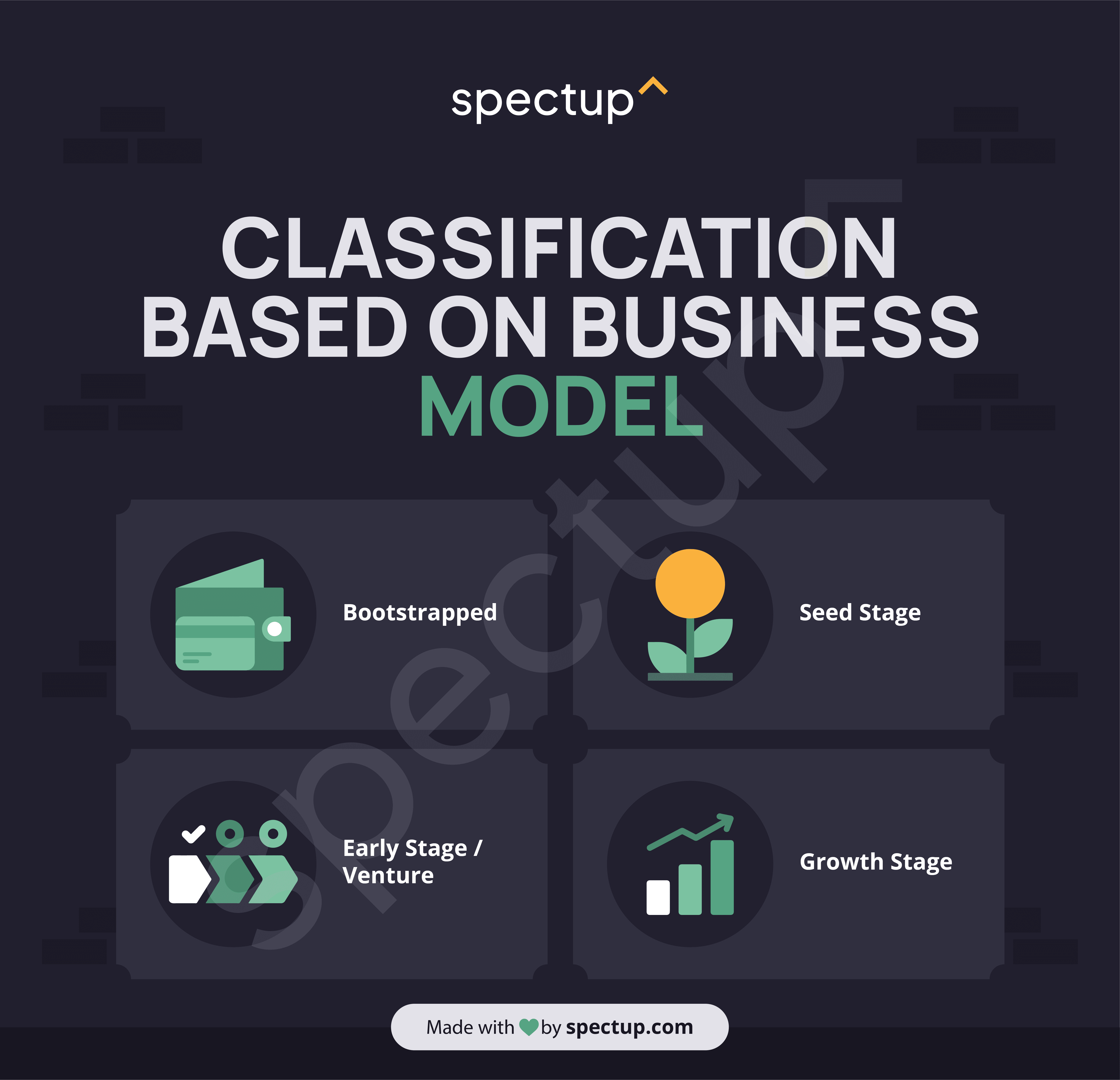
Bootstrapped
These startups are self-financed, often relying on the founders' savings, initial sales, or other non-external sources of revenue. Bootstrapping requires resourcefulness since there's no cushion of external investment. However, it allows founders to retain full control and equity in their business. Companies like Basecamp and MailChimp are prime examples of successful bootstrapped ventures.
Seed Stage
This is the initial stage of external funding. Startups in this phase may have a prototype or a minimum viable product (MVP) but are usually pre-revenue. Investments during this stage often come from angel investors, early-stage venture capitalists, or crowdfunding campaigns. The goal is to refine the product and achieve market fit. Notable companies, like Dropbox, began their journey with seed funding, which you can much easier with an investor outreach plan.
Early Stage/Venture
By this stage, startups typically have a proven product and some traction, but they need funds to scale their operations, expand their team, or enter new markets. Venture capital firms are the primary investors here, looking for startups with high growth potential. A company like Snap Inc., the parent company of Snapchat, went through this stage before becoming a household name.
Growth Stage
Startups in the growth stage have established their market presence and are looking to expand aggressively. Their products are well-received, and they might be eyeing international markets or broader customer segments. Funding here comes from larger venture capital firms, private equity, or even pre-IPO rounds. Think of companies like Airbnb or Spotify in their pre-public days.
In summation, the funding stage not only signifies the financial milestones of a startup but also provides a roadmap of its journey. From humble self-funded beginnings to grand rounds with big-ticket investments, each stage shapes the narrative, strategy, and trajectory of a startup.
Classification Based on Growth & Scalability
The rate at which a startup aims to grow and its potential to scale are pivotal factors determining its operational strategy, risk appetite, and market approach. From ambitious unicorns aiming for global dominance to small-scale ventures content with serving a niche community, the spectrum is vast. Here's a detailed look:
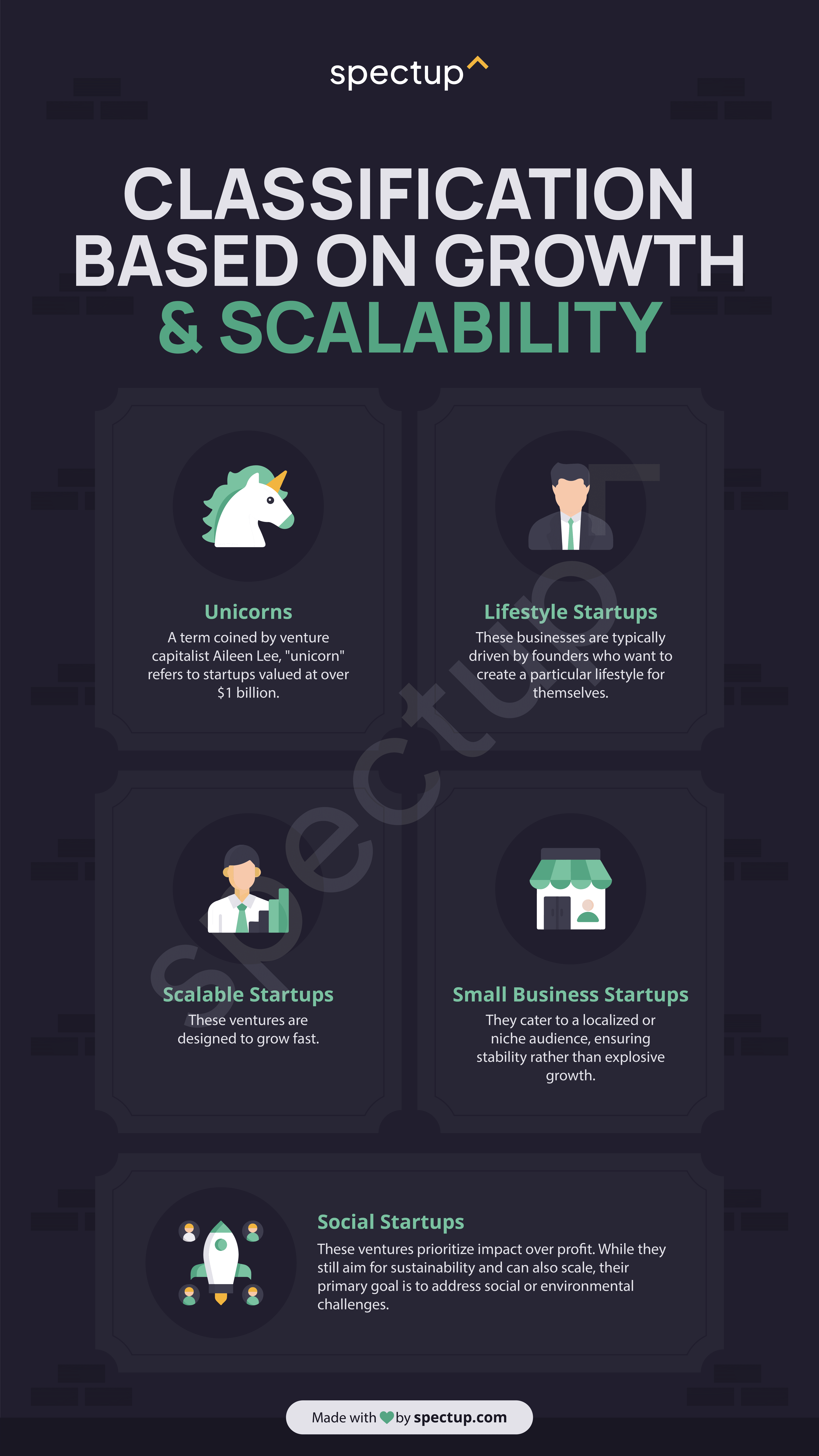
Unicorns
A term coined by venture capitalist Aileen Lee, "unicorn" refers to startups valued at over $1 billion. These startups aim for rapid growth and massive scalability. Their business models often hinge on network effects, where the service becomes more valuable as more people use it. Famous examples include Uber, Airbnb, and ByteDance.
Lifestyle Startups
These businesses are typically driven by founders who want to create a particular lifestyle for themselves. Rather than chasing exponential growth, they prioritize work-life balance or aligning work with personal passions. An independent cafe owner or a freelance travel blogger might fit this mold.
Scalable Startups
These ventures are designed to grow fast. While they might not aim for unicorn status, they seek significant growth and are built on scalable models. They often start with a comprehensive market analysis, ensuring there's a large enough audience for their product or service. SaaS (Software as a Service) companies like Asana or HubSpot can be classified under scalable startups.
Small Business Startups
These startups don’t aim for global reach or rapid scale but play an essential role in local economies. They cater to a localized or niche audience, ensuring stability rather than explosive growth. This category includes most restaurants, retail shops, and local service providers.
Social Startups
These ventures prioritize impact over profit. While they still aim for sustainability and can also scale, their primary goal is to address social or environmental challenges. Organizations like Grameen Bank, which focuses on microloans to alleviate poverty, or TOMS Shoes, which donates a pair of shoes for every pair sold, embody this ethos.
In essence, a startup's growth and scalability objectives provide a lens into its long-term vision, market strategy, and value proposition. Whether shooting for the stars with unicorn aspirations or making a mark in a localized community, each startup's trajectory is a blend of ambition, opportunity, and strategy.
Conclusion
The world of startups is as vast as it is varied. As we've traversed through this guide, it becomes evident that the term 'startup' isn't monolithic. From the industry they choose to operate in, the innovations they bring to the table, the business models they adopt, to their growth ambitions and funding strategies – each decision crafts a unique narrative and trajectory for the venture.
Understanding these classifications is more than just an academic exercise. For entrepreneurs, it provides clarity on their vision and the journey ahead. For investors, it offers insights into potential risks and returns. For consumers and the broader community, it demystifies the businesses shaping our tomorrow.
The startup ecosystem continues to evolve, with new categories likely to emerge, and existing ones to meld or pivot. Yet, the constant remains: the spirit of innovation, resilience, and a desire to leave an indelible mark in the sands of commerce and society.
As we wrap up this exploration, let’s celebrate the myriad faces of startups, recognizing that each venture – be it a unicorn racing towards global dominance or a lifestyle startup enriching a local community – contributes to the vibrant tapestry of our global economy.
Niclas Schlopsna
Partner
Ex-banker, drove scale at N26, launched new ventures at Deloitte, and built from scratch across three startup ecosystems.








